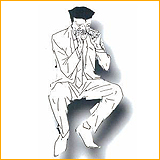| Mental Health Tips | |
| Common Mental Problems | |
| Substance Misuse | |
| Treatment of Mental Disorders | |
| Mental Health Education Pamphlets | |
 Ketamine
Ketamine
(Special thanks to Dr Ricky Tung of Institute of Mental Health, Castle Peak Hospital, for authoring this article)
1. What is ketamine?
2. How is ketamine being consumed?
3. How does it feel after using ketamine?
4. What is the harm ketamine can cause to brain?
5. Is ketamine addictive?
1. What is ketamine?
Ketamine is an anesthetic agent. The anesthetic effect has rapid onset, short duration and minimal effect on breathing. Therefore, it is commonly used in surgery on children and animals. It is the preferred choice for anaesthetics in adverse environment, such as battlefield or natural disaster. Those ketamine used in medical settings is a colorless solution for injection into bloodstream. On the other hand, those used by recreational drug users is made into white powder, which is easier for use and trafficking. Because of the relative low cost, easier availability and the ease of consumption, ketamine is the most commonly abused drug in Hong Kong, especially among young people.
2. How is ketamine being consumed?
Ketamine powder is usually snorted into the nose, being absorbed by the blood vessels lining the inner surface of nose. Subsequently it is being delivered to the brain and gives rise to a rapid onset of effect. Abusers usually grind the ketamine into finer powder and then align it into a row. With the help of a piece of straw, this row of ketamine powder is insufflated into nostril. Some abusers might simply place the ketamine powder on the back of hand, a card or a spoon to snort it.
3. How does it feel after using ketamine?
Ketamine is a dissociative anesthetic agent. It is described as “dissociative” because it can lead to a disruption of normal integration of a person’s conscious and psychological functioning. The person might feel the external environment being “unreal” and far away from him. He might experience hallucination, feeling weightless, or “his soul leaving his body”.
After using ketamine, the person would appear dull to external observation. After one to two hours, when the acute effect of ketamine has dampened, the person would gradually become more responsive, but he may still have slurred speech and appears confused for hours.
If the dose of ketamine is small or the abuser has developed some tolerance to its effect, he might only feel light-headed, dizziness or relaxed (a bit similar to the experience of drunkenness with alcohol) for around half an hour.
4. What is the harm ketamine can cause to brain?
Medical research has established that ketamine harms the brain cells, particularly when being consumed with alcohol. Therefore ketamine abusers suffer from impaired memory, difficulty in concentration, lowered intelligence and decline in academic and vocational functioning. A research has found that some ex-abusers of ketamine might have recovery on some of the impaired cognitive functions after they stop ketamine use entirely. Ketamine can also cause unstable mood, depression and anxiety.
It is well known that ketamine abuse results in a series of physical damage, such as upper abdominal pain (so called the “K-cramp”), urinary problems (including frequent urge to void, pain in voiding, blood in urine, kidney diseases), nasal damage due to chronic irritation (including blocked nose, runny nose, difficulty in breathing or even perforation of the wall between two nostrils). Although these physical complications do not happen in every ketamine abuser, they can happen to any ketamine abuser, including those who have only used a relatively small amount or for a short time.
5. Is ketamine addictive?
Ketamine is certainly addictive. Although abrupt cessation of ketamine use does not cause withdrawal symptoms in everyone, persistent ketamine use produces intense psychological craving, which is similar to those in heroin or amphetamine users. Ketamine users often start with casual use of ketamine with peers in disco or pub. Gradually, the psychological craving makes them consume more and more, to the extent that they have to give up all social life or hobby, staying at home and using ketamine for most of the time. The psychological craving goes so overwhelming that use of ketamine completely occupies the person’s life.
Websites with relevant information / Reference
Government antidrug website|
================================================================================ Thank you for browsing the mental health tips on the IMH internet. We would like to hear feedback from you through the questionnaire below. Your comments are most welcome for our continuous improvement. |
No. of visitors of this page: 7816


